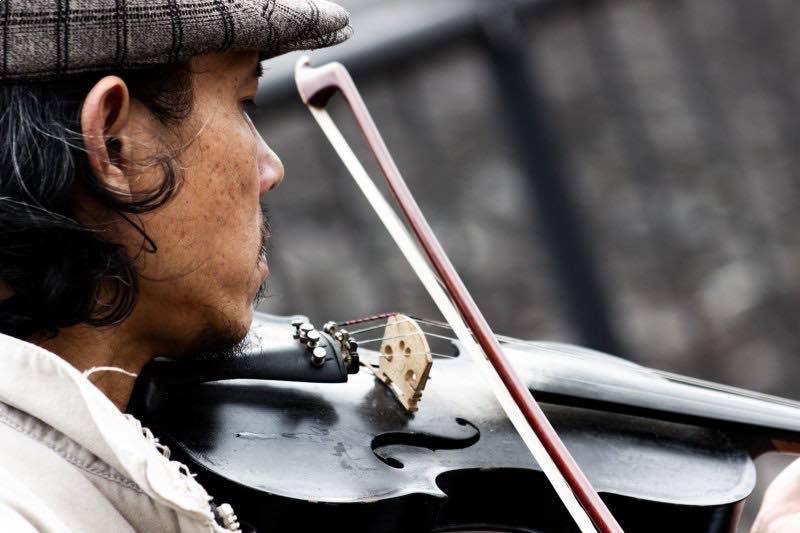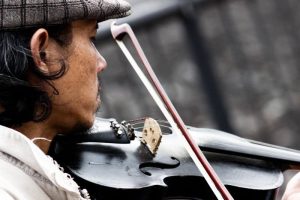One of the earliest skills you’ll acquire as a beginning violinist is learning about the parts of your instrument, including the violin string names.
Though Roman Numerals are sometimes used to reference the violin’s strings in advanced repertoire. The most common names for violin strings comes from the pitch that particular string produces. The names we use for the violin’s strings are: E, A, D, and G.
Your teacher may offer the mnemonic “Every Ant Digs in the Ground” to help you memorize these string names right away!
Understanding Violin Sounds & Violin String Names
Did you know that musicians use a huge vocabulary of words to describe sound? Sound can be raucous or mellow, piercing or dulcet, loud or soft, and high or low. It’s this last category that is important when it comes to a violin’s string names.
A high sound, or high pitch, also has a high frequency, a metric used to discuss the science of sound. Musicians also use the word “interval” to refer to the space between certain sounds. The interval between each of the violin’s strings is a “Perfect Fifth,” which basically means that 5 letters separate the names of each string: G-A-B-C-D or D-E-F-G-A or A-B-C-D-E.
Violins, violas, and cellos all use the interval of a perfect fifth to tune their open strings.
Tuning Your A String to 440Hz
Today, most violinists agree that the A string pitch should be tuned to 440Hz, with all other strings tuned a fifth apart. Therefore, a violin tuned for classical music would produce approximate frequencies of 196Hz (G string), 294Hz (D string), 440Hz (A string), and 659Hz (E string).
Countless tuning devices and apps exist to help violinists align their instruments to these pitches, and all of them work from the same concept of temperament. For more visual learners, pressing keys on a piano might help understand the spaces in sound between these notes: G3 is the G key just below Middle C, D4 is one whole step above Middle C, A4 and E5 are the next closest A and E keys above Middle C.
A Brief History of Violin Tuning
This system was not always so straightforward! In the early years of violin playing, strings were tuned in all sorts of ways. And it wasn’t uncommon to hear a different “A” in every town you visited. In part, this had to do with the type of material of which violin strings were made.
For hundreds of years, strings were made out of sheep intestine (called “catgut”). This was stretched and spun, cut and dried, and fashioned to attach to violins. As you can imagine, this process was far from uniform and yielded strings of wildly different gauge, flexibility, and durability.
Some of the earliest descriptions of tuning instructed the violinist to stretch their E strings to the highest pitch possible. Then, tune each lower string in fifths relative to that top sound. Suffice to say, many E strings snapped during this process!
The combination of factors including traveling composers, touring artists, recordings and radio broadcasts, and the introduction of synthetic and metal-wound strings helped codify the violin tuning practices around the world.
Today, classical musicians refer to deviations from the standard tuning as “scordatura,” from the Italian word for “discord.” A famous example of scordatura in classical music is from Danse Macabre by Camille Saint-Saëns, wherein the solo violin screeches an eerie double stop of their open A and E strings, only with the E string tuned down to E-flat.
Violin String Tuning is Versatile Outside the Classical Genre
The violin’s tuning remains as versatile as ever outside of the classical music genre. Carnanic, Hindustani, and Arabic violinists tune their strings using two pitches (letter names). The strings are tuned in octaves for a total of four frequencies.
Turkish violinists may deviate slightly from “standard” classical tuning to use D, A, D, G. And the traditional folk and fiddle music of the Americas also offer a variety of tuning systems. These have names such as “sawmill tuning,” “dee-dad,” “black mountain rag,” and others which are collectively referred to as “cross-tuning.”
Learning the string names is just one of many basic skills you’ll learn in violin lessons, with others such as holding the violin, learning where to place your fingers, holding the bow, drawing a clear and characteristic tone from the instrument, and reading music notation. Each basic skill is important in its own way. And each has been formed and refined over many years so that today’s beginning violinists learn the most effective way to play and perform!
Lauren Ellis Scott

